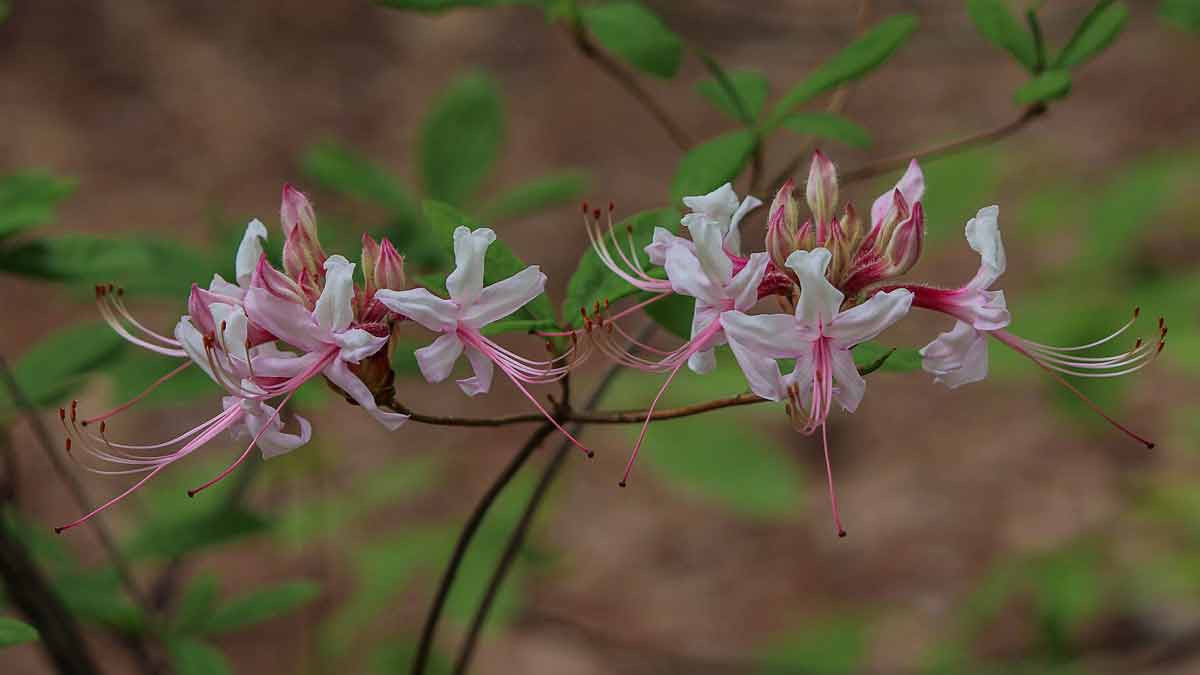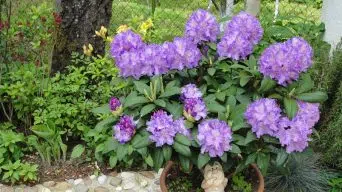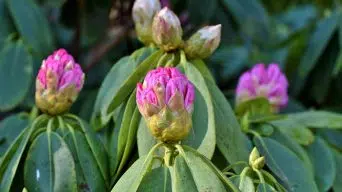Rhododendron plants are known for their beautiful, vibrant flowers. They are a popular choice for gardens and landscaping because of their showy blooms and easy care.
However, rhododendrons sometimes become leggy, meaning they have long stems with few leaves. This can be caused by several factors, including too little light or too much fertilizer.
Leggy rhododendrons are not as attractive as fuller plants and are more likely to succumb to pests and diseases.
But don’t worry; you can take a few easy steps to fix a leggy rhododendron.
What Causes a Rhododendron to Become Leggy
Rhododendron plants are native to woodlands and mountainous regions, where they grow under the shade of trees. In these natural habitats, rhododendrons receive dappled sunlight throughout the day.
When grown in gardens or yards, rhododendrons need similar conditions to thrive. They should be planted in an area that receives 4-6 hours of sunlight daily, preferably in the morning or early afternoon.
Rhododendrons that don’t receive enough light are more likely to become leggy. The plants will stretch towards the sun in an attempt to get more light, resulting in long, thin stems.
Another common cause of leggy rhododendron plants is overfertilization. Rhododendrons are light feeders, meaning they don’t need much fertilizer to grow well.
Applying too much fertilizer, or using a fertilizer with high nitrogen content, can cause the plant to produce more leaves and fewer flowers. It can also lead to leggy growth.
Overfertilization is a common problem with rhododendrons because many assume that more fertilizer is better. However, this is not the case and can do more harm than good.
How To Tell If a Rhododendron Is Leggy
It’s not always easy to tell if a rhododendron is leggy just by looking at it. Sometimes, the plant may need more time to fill out or may be going through a natural growth spurt.
There are a few telltale signs that can help you determine if your rhododendron is leggy:
The Plant Is Tall and Spindly
When rhododendrons become leggy, they often grow taller and thinner. The plant is stretching towards the sun to get more light.
If your rhododendron is much taller than it was when you first bought it, or if the stem seems thinner than usual, it may be leggy.
There Are Fewer Leaves Than Normal
Rhododendrons typically have glossy, dark green leaves.
If the plant is leggy, it will have fewer leaves than usual because the energy goes towards stem growth rather than leaf production.
As a result, the leaves may be smaller than usual or have changed color. They may also be spaced further apart than usual.
The Flowers Are Fewer and Smaller Than Normal
Rhododendrons are known for their large, showy flowers. If the plant is leggy, the flowers will be smaller than usual, and there will be fewer.
This is because the plant is not getting enough light to produce the energy it needs for flower production.
The Plant Is Not Growing New Leaves or Flowers
If your rhododendron is leggy, it may stop growing new leaves and flowers. This is because the plant is not getting enough light to produce the energy it needs for growth.
As a result, the plant will become stunted and will eventually die.
The Plant Is Drooping
Rhododendrons are normally very upright plants.
The plant may start to droop or sag in the middle if it is leggy. This is because the stem is not strong enough to support the weight of the leaves and flowers.
The Plant Has Yellow or Brown Leaves
Rhododendrons typically have dark green leaves.
If the plant is leggy, the leaves may turn yellow or brown. This is because the plant is not getting enough light to produce chlorophyll, which gives leaves their green color.
The Plant Is Falling Over
If your rhododendron is leggy, it may start to fall over. The plant is not getting enough light to produce the energy it needs to stay upright.
As a result, the plant will become top-heavy and eventually topple over.
The Plant Looks Weak and Sickly
If your rhododendron appears leggy, it may seem weak and unhealthy due to insufficient light. The plant requires more light to generate the necessary energy to maintain health.
The leaves may be yellow or brown, and the stem may be thin and spindly. The plant may also have fewer leaves and flowers than usual.
How To Fix a Leggy Rhododendron
There are a few things you can do to fix a leggy rhododendron:
Move Your Plant to a Bright Location
Rhododendrons thrive in bright, indirect sunlight. If your plant is in a shady spot, it may become leggy in an attempt to get more light.
To fix this, move your plant to a brighter location. Ideally, it would help if you placed it in an east- or west-facing window.
If you live in a very hot climate, you may need to provide some afternoon shade to prevent the leaves from scorching.
Too much direct sunlight can also be harmful, so monitor your plant and move it if necessary.
Prune Your Plant
Pruning is a great way to encourage bushier growth and can help fix a leggy rhododendron.
Cut back the longest stems by a few inches to prune your plant. This will encourage the plant to produce new, shorter stems.
You can also remove any leaves that are yellow or brown. This will help the plant focus its energy on new growth.
Don’t Fertilize Your Plant
Fertilizing your plant will encourage it to produce new growth.
If your plant is already leggy, this will only make the problem worse.
To fix a leggy rhododendron, you should avoid fertilizing it until it has recovered.
If your rhododendron is leggy due to overfertilization, you can flush the soil with water to remove any excess fertilizer.
To do this, water your plant deeply and allow the water to drain out. Repeat this process a few times until the water runs clear.
Don’t fertilize your plant for a few months to allow it to recover. When you start fertilizing again, use a half-strength fertilizer and only fertilize every other month during the growing season.
Provide Support
If your rhododendron is leggy and in danger of falling over, you can provide some support to prevent it from toppling over.
To do this, insert a stake into the ground next to the plant and tie the plant to the stake with twine or string.
Make sure to use a soft material that won’t damage the stem. You may need to adjust the support as the plant grows.
Be Patient
It can take some time for a leggy rhododendron plant to recover. Once you’ve taken steps to improve the plant’s environment and prune it back, be patient and allow the plant time to grow.
Your leggy rhododendron will soon look healthy and bushy again with some care and attention.
How to Prune a Leggy Rhododendron
Pruning rhododendrons is a great way to encourage bushier growth and can help fix leggy growth.
To prune your rhododendron, cut back the longest stems. Cut each stem back by a few inches, careful not to damage the plant.
Make your cuts above a set of leaves, encouraging the plant to produce new growth.
You can also remove any leaves that are yellow or brown. This will help the plant focus its energy on new growth.
When pruning, always make clean cuts and avoid tearing the stems. This can damage the plant and make it more susceptible to disease.
After you have finished pruning, water your plant deeply and give it time to recover.
Ensure that you have a sharp pair of pruning shears to make clean cuts. You should also disinfect your pruning shears before and after use to prevent the spread of disease.
To do this, dip the blades in a solution of one part bleach and nine parts water.
When to Prune a Leggy Rhododendron
The best time to prune a leggy rhododendron is in late winter or early spring before new growth begins.
This will give the plant time to recover and produce new growth before the growing season begins.
If you live in a cold climate, you may need to wait until the last frost has passed before pruning your plant.
How To Prevent a Leggy Rhododendron
You can do a few things to prevent your rhododendron from becoming leggy.
Some things you can do are:
Make Sure Your Plant Is Getting Enough Sunlight
Rhododendrons need at least four hours of sunlight each day to stay healthy. If your plant is not getting enough sunlight, it will become leggy as it stretches towards the light.
Provide some shade during the hottest part of the day if your plant is in full sun.
You can also move your plant to a location that receives more sunlight. Just do this gradually so the plant can adjust to the new light level.
Turn Your Plant Every Few Days
Rhododendrons grow best when they’re turned every few days. This helps them to distribute the light evenly they’re receiving.
If your plant is in a fixed location, such as in a south-facing window, it may become leggy if it’s not turned regularly.
Turn your plant a quarter turn every few days, so it gets evenly lit on all sides. This will help to prevent leggy growth.
Trim Back Your Plant Regularly
Trimming back your rhododendron will encourage it to branch out. This will help to prevent leggy growth.
Trim back the plant by a third every few months. Use sharp, clean pruning shears to avoid damaging the plant.
Don’t OverFertilize
Rhododendrons don’t need a lot of fertilizer to stay healthy. Too much fertilizer can lead to leggy growth.
Fertilize your plant once a month during the growing season. Use a balanced fertilizer that is specifically made for rhododendrons.
Follow the directions on the fertilizer package, and don’t fertilize more than what is recommended.
Avoid using a high-nitrogen fertilizer, as this can encourage leggy growth.
Keep Your Plant Healthy
A healthy rhododendron is less likely to become leggy. Ensure your plant gets enough water and sunlight, and fertilize it regularly.
If your plant becomes stressed, it may stretch out and become leggy. Watch for signs of stress, such as yellowing leaves or wilting, and take corrective action immediately.
Following these tips can help prevent your rhododendron from becoming leggy.
Final Thoughts
Rhododendron plants are popular for their beauty and ease of care. Though they’re generally trouble-free, leggy growth is a common problem.
If your rhododendron is leggy, don’t despair.
With a bit of pruning and the right light, you can encourage compact, bushy growth that will restore your plant’s beauty.
When it comes to pruning, the key is to do it regularly and selectively. Remove only the longest, leggiest branches, and leave plenty of shorter, healthier growth in place.
You can also encourage bushier growth by giving your rhododendron the right amount of light. Low light can cause leggy growth, so provide bright but indirect light.
You can fix a leggy rhododendron with some care and enjoy its beauty for years.







